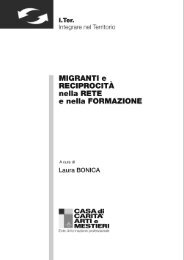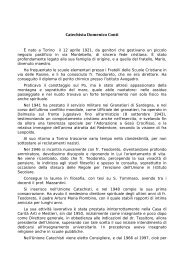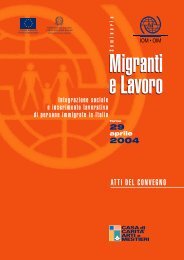Rapporto finale/ Final Report (ITA-ENG) - Casa di Carità Arti e Mestieri
Rapporto finale/ Final Report (ITA-ENG) - Casa di Carità Arti e Mestieri
Rapporto finale/ Final Report (ITA-ENG) - Casa di Carità Arti e Mestieri
You also want an ePaper? Increase the reach of your titles
YUMPU automatically turns print PDFs into web optimized ePapers that Google loves.
54<br />
The <strong>di</strong>versity of contexts also resulted in a <strong>di</strong>versity of targets which was, at times, substantial. Although<br />
the activities targeted second-generation migrant students in all four countries, the characteristics<br />
or each target group varied from case to case.<br />
For instance, young detainees or youths involved in the criminal justice system were only involved in<br />
the project in Italy. Also in Italy, the schools targeted by the partner Il Nostro Pianeta mainly consisted<br />
of pupils in classes three and four, many of whom were girls. At these schools preference was given<br />
to students atten<strong>di</strong>ng state vocational training courses over those studying for a <strong>di</strong>ploma, to comply<br />
more closely with the project’s target group.<br />
In Germany there was a course specifically for the <strong>di</strong>sabled and for young people who, having suffered<br />
a physical or psychological trauma following a road accident, or other similar event, were forced to<br />
change their job. This partner also chose to include migrants and natives in the position of having to<br />
change career paths. The learners included by this partner were slightly older than those in the other<br />
countries (15 – 18 in Italy, France, Spain; 25 – 30 in Germany).<br />
In France, one set of activities in particular addressed students following a separate learning path.<br />
Some activities involved pupils at schools as well as young people atten<strong>di</strong>ng neighbourhood community<br />
centres in the city of Lyon.<br />
In Spain the young people involved, aged between 16 and 23, were in the last year of compulsory<br />
education, at secondary school or on vocational training courses.<br />
The positive aspect of the variegated scenario described above is that, despite the practical<br />
<strong>di</strong>fficulties described later on in this report, it was possible to test a plurality of factors and<br />
methods of action.<br />
Comparative research methods were used to compare these and identify the most effective means<br />
for respon<strong>di</strong>ng to problems of intolerance and <strong>di</strong>scrimination in educational contexts: these elements<br />
are highlighted and analysed in the following pages.<br />
HOW IS DISCRIMINATION MANIFESTED AT SCHOOL?<br />
THE MAIN ASPECTS OF DISCRIMINATION THAT EMERGED IN<br />
THE EUROPEAN CONTEXTS<br />
Despite the great <strong>di</strong>versity of the contexts in which the Cross Community Schools project was conducted,<br />
it was somewhat surprising to note that the <strong>di</strong>fferent aspects of <strong>di</strong>scrimination are frequently<br />
manifested in the same way and that stereotypes, even if not <strong>di</strong>scriminated against or subject to<br />
intolerance, frequently recur in very <strong>di</strong>fferent national and educational contexts.<br />
The preliminary analysis of the most widespread forms of <strong>di</strong>scrimination provided an important starting<br />
point for the partners in the project to <strong>di</strong>scuss the problems to be addressed and guide their subsequent<br />
choice of the issues to be dealt with and the <strong>di</strong>fferent ways of doing so.







